Review and photos by Bokisaurus
Greetings dinofans! Since 2019 is shaping up to be the year of the Spinosaurus, I figured it would be a great way to celebrate it by reviewing Safari’s new for 2019 swimming Spinosaurus. The review is longer than I wanted it to be, but with a species that already is one of the most reviewed figure, I wanted to add just a little bit of its history in the toy world.
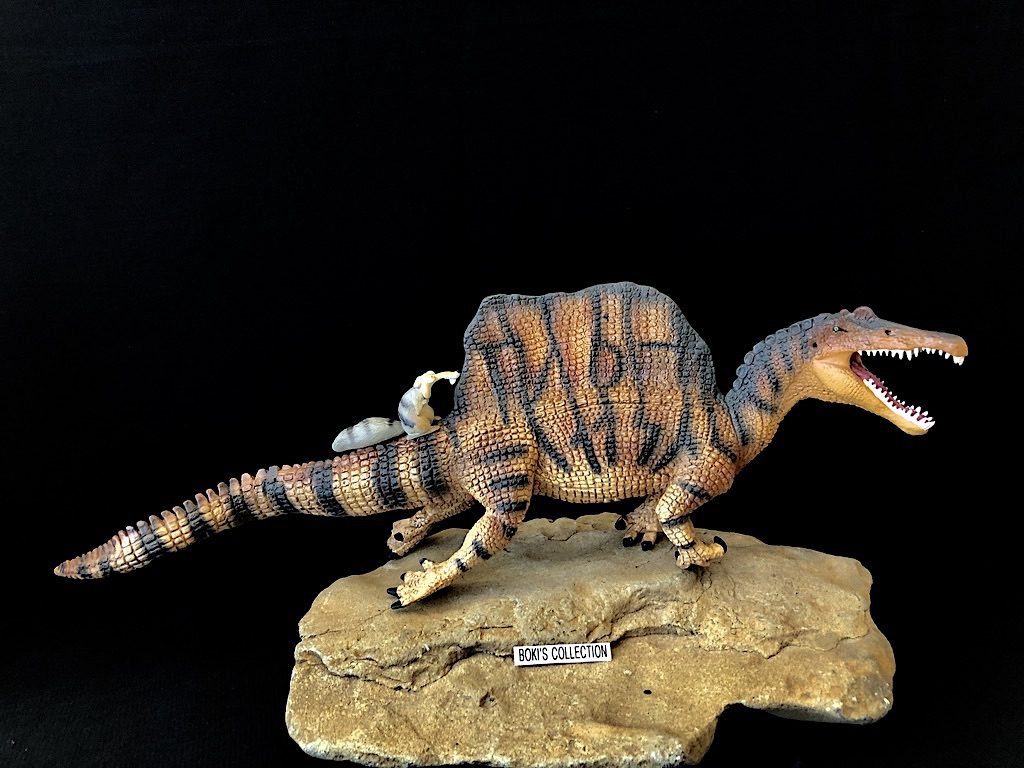
Spinosaurus (meaning spine lizard) is one dinosaur that is shrouded in mystery and, as it turned out, full of surprises as well. Today, Spinosaurus is one of the most popular and famous of all the dinosaurs. Like the undisputed king of multi-media, the Tyrannosaurus rex, it seems like Spinosaurus is everywhere these days. But it wasn’t always this way.
The first fossils were discovered back in 1912 by a guy named Richard Markgraf in Egypt’s Bahariya Formation.In 1915 the German paleontologist Ernst Stromer described it as a new species and was given the name Spinosaurus aegyptiacus (meaning Egyptian spine lizard).
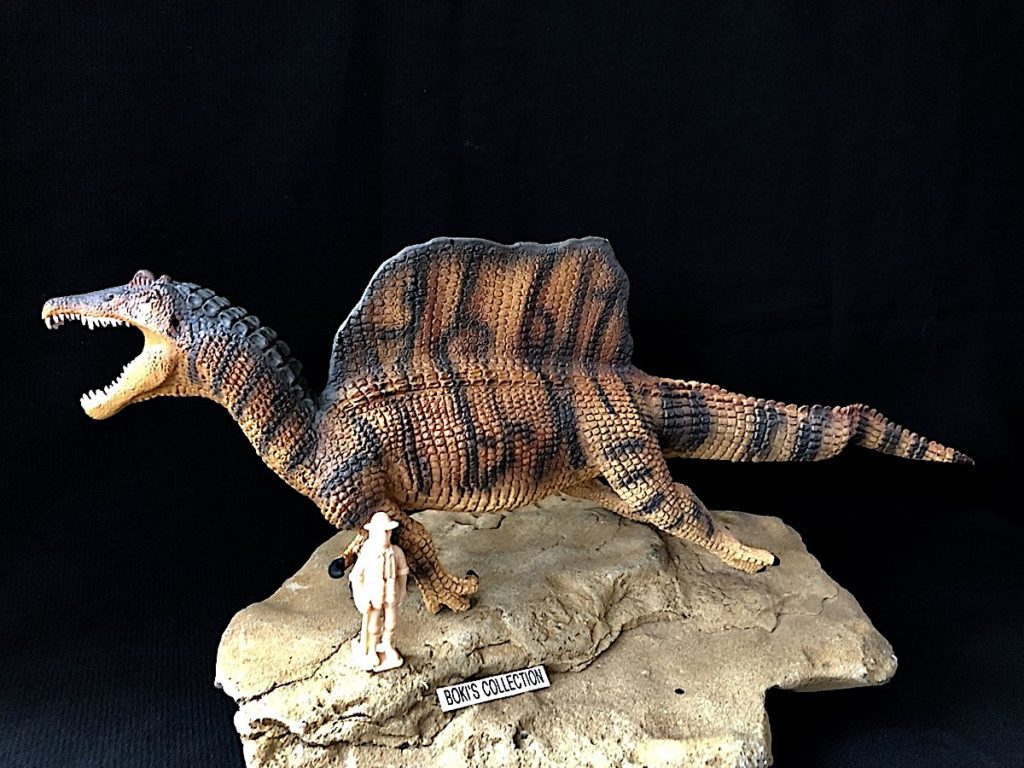
The fossil was very incomplete, but enough material was found to determine that this was one weird animal and very much unlike any other large carnivorous dinosaur found so far. What made Spinosaurus unique was that it sported a long and tall neural spine, something not seen in any other large theropods.
Although it was one of the largest predator dinosaur in the world, it was not as bulky as some of the true titan such as Tyrannosaurus. It also shared its habitat with other large land predators as well as some aquatic ones. The differences in each of these predators diet is what allowed them to coexist without directly competing with each other for food supply.
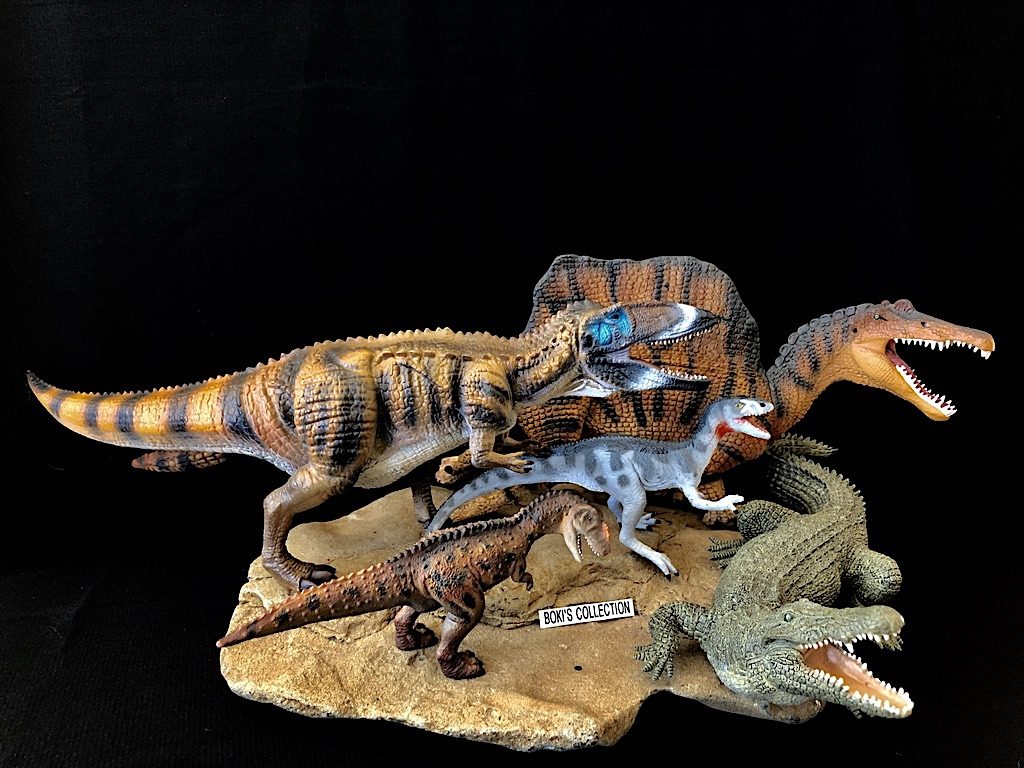
The holotype specimen was tragically destroyed during the WWII. In the ensuring decades since its discovery, no new fossil material that could shed light as to Spinosaurus true identity were found. All there was to go with are those old reconstructions photos and sketches.
The original Stromer reconstruction shows Spinosaurus as being bipedal animal, with a large crescent shaped sail on its back. Since the skull was unknown at that time, it was given a boxy generic large theropod skull. This was how it was depicted for decades. This can be seen clearly in Safari’s first Spinosaurus version released under the Carnegie line.
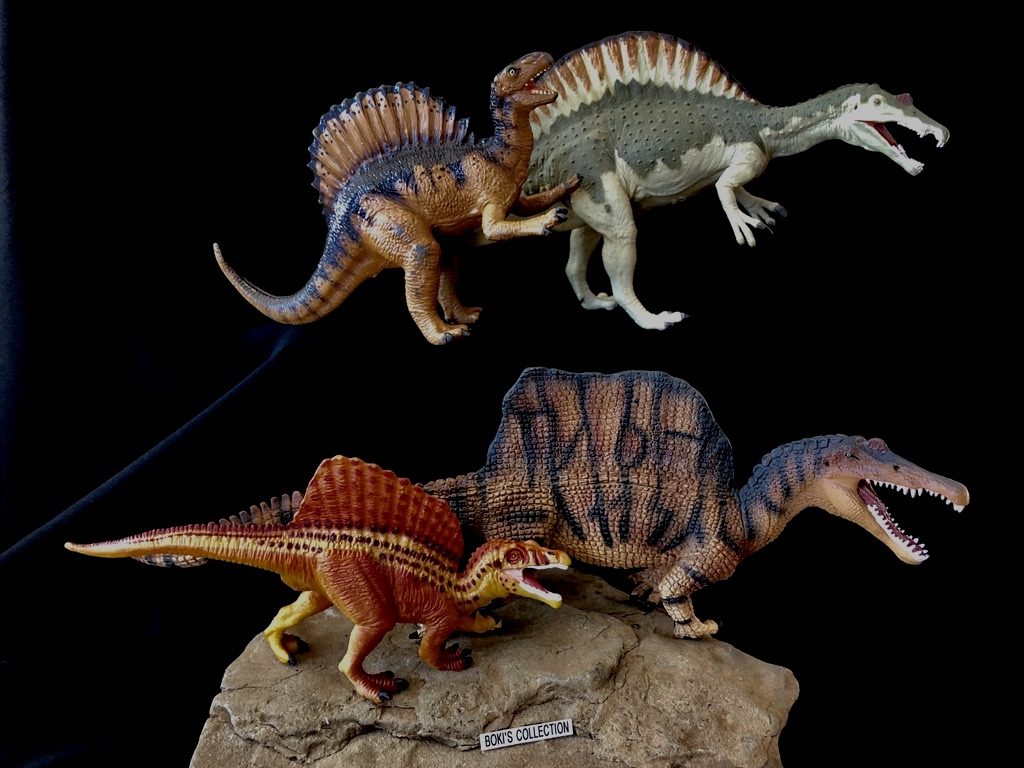
Although typically depicted as a biped, there were early suggestions that Spinosaurus was at least a part-time quadruped. This idea was partly based on one of its close relative, the Baryony, who’s arms are robust. This idea didn’t catch on, however, this look was immortalized by a few toy figures, which one happens to be another figure from Safari released under their Wild Safari line. This smaller figure ( the orange one in the photo above) also show a change in skull shape as well as the sail.
In the 1990’s, Spinosaurus’s quiet time in the shadows was about to end. In this decade, an explosion of discoveries would help shed new light on how this animal appeared. Fossils of Spinosaurus’s close relatives were being discovered in Europe, Africa, Asia, and South America, giving us a glimpse of how it may have looked.
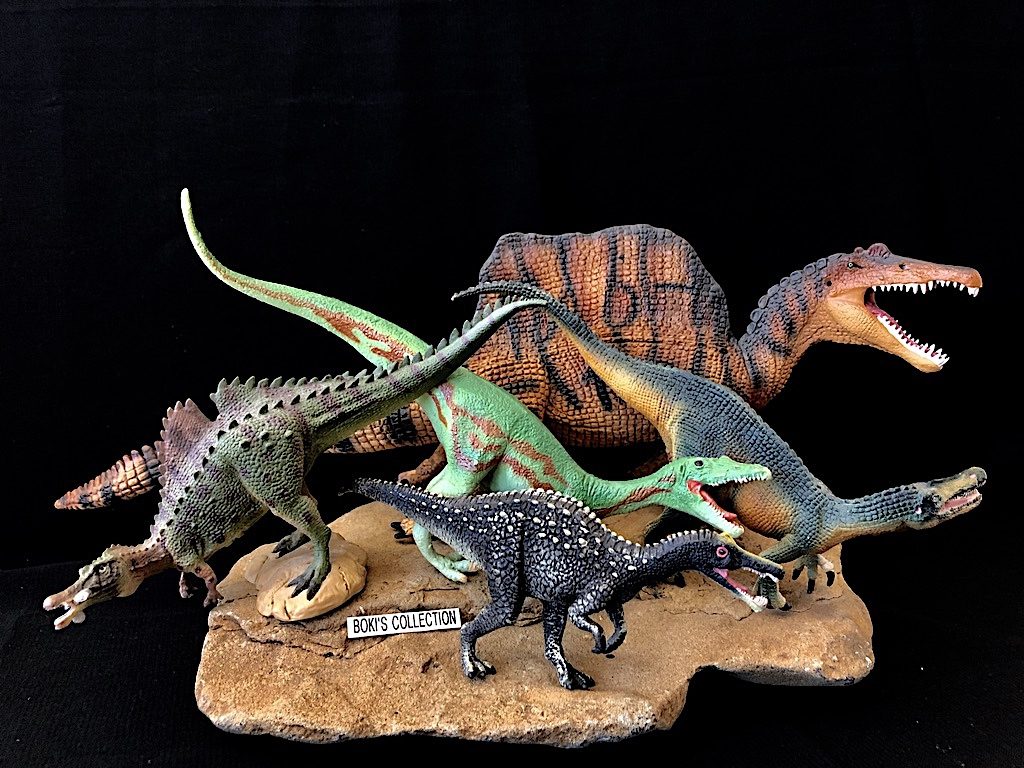
Based on these new discoveries, a common feature that clearly emerged from all of these was that Spinosaurus and its relatives have a much narrower snout filled with long conical teeth, but unlike other carnivorous theropods, these teeth were not serrated.
So, a new look was born, one that shows an animal with a more horizontal stance, a big sail on its back, and a long and narrow snout full of conical teeth. This looks is seen in the second Carnegie version. As the 1990’s came to a close, another, much more exciting era was about to begin for Spinosaurus, one that would forever change our view of this enigmatic species.
Jurassica Park and its many sequels have proven to be so successful that any dinosaurs that appeared on screen was destined to be a household name. In 2001 Jurassic Park III was released. In the previous two films, Tyrannosaurus was the undisputed star. For the third installment, producers wanted something new. Enter Spinosaurus.
Finally, after decades of obscurity,Spinosaurus was in the spotlight! Although it shared the screen with the undisputed Mr. T, it held its own and captured the admiration and imagination of millions of viewers worldwide. Overnight, Spinosaurus went from obscure to being one of the most famous dinosaur of all time. It wasn’t long before it reached that iconic status.
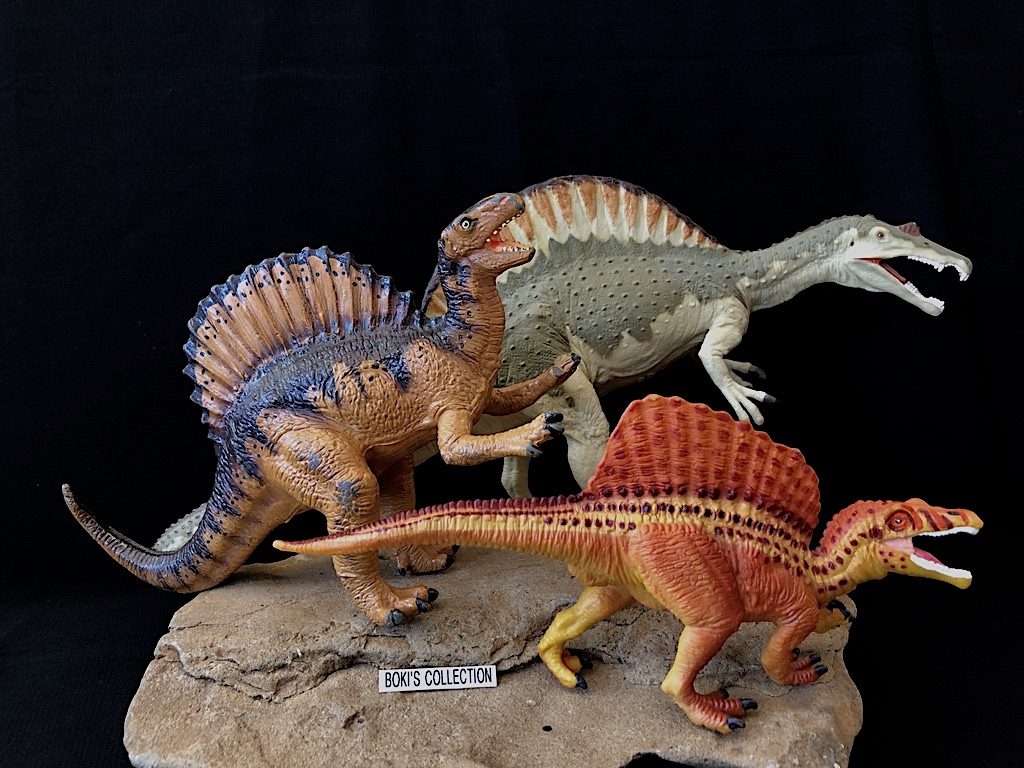
Then as a new decade begins, an exciting find would once again change how Spinosaurus look.
In 2014, Nizar Ibrahim, Paul Sereno and their colleagues would release a paper that would completely change not just how Spinosaurus look, but also how it lived. The newly unveiled paper was released with great fanfare, full of media blitz, a life size reconstruction, and a full length documentary.
So as the world watch, Spinosaurus had gone from a biped super carnivore to obligatory quadrupedal animal that lead a semi-aquatic life.
The unique and distinguishing features such as the crocodile-like snout and tall sail on its back are still there. The biggest change can be seen in the leg proportion and its posture, as well as it being a semi-aquatic animal who hunted mostly in the water for fish. This lifestyle would make Spinosaurus the first large dinosaur to live such an aquatic lifestyle.
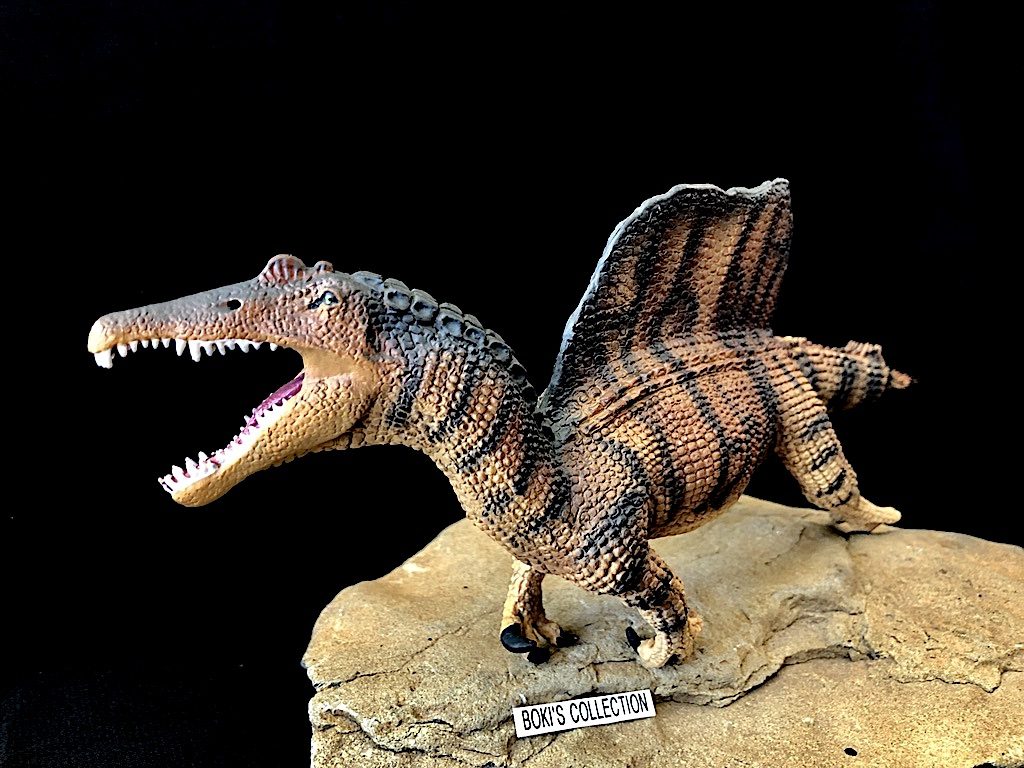
As expected, this new reconstruction was met with controversies and resistance, setting social media ablaze with lively discussions. But there is enough and strong evidence that supported this new findings, allowing it to endure the initial onslaught of criticism and skepticism.
It would be 2 years after the announcement that we would see a toy version of Spinosaurus in this new reconstruction. No surprise, CollectA bravely lead the way, releasing not one, but 3 figures in this new look. One of the figure would show how it may have moved on land, and the other shows it as swimming. It was a risky move, one that could easily made their figures obsolete, after all the ink is not yet dry and the storm and controversy that followed the announcement still swirling at full force. But once again, it endured, which brings us to our subject. For today’s review, we will take a look at Safari’s latest version based on this new reconstruction.

I’m sure I wasn’t the only one who was curious about what a new Spinosaurus from Safari would look like. Well, that curiosity was satisfied this year with the release of their swimming Spinosaurus. I had high hopes for this figure.
As the official name says, this figure is in a swimming pose. This is also the largest figure from their 2019 lineup, measuring in at almost 12” inches from nose tip to tail tip stretched out, and just under 5” tall. This make it a 1:35 scale figure.
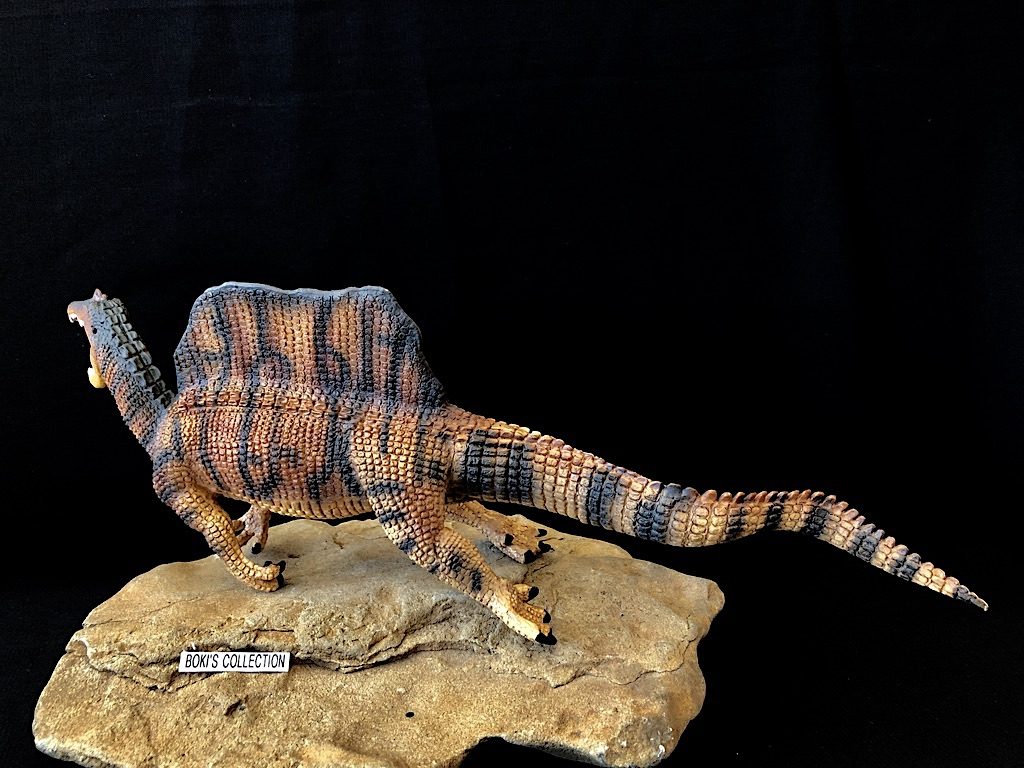
There is no denying that it is one impressive figure, but it is also one that has many missed opportunities in my opinion.
No doubt the sculpting is top of the line, and that a lot of researched was done to produce it. The figure match up pretty well with the new Ibrahim/Serano reconstruction which it was based on.
The head is sculpted nicely with beautiful details, from the small scales to the delicate nostrils. The mouth is wide open, showing off its pearly white teeth. Fortunately, the teeth are not so blunted and still retain some of its conical and pointy shape. The paint job on it is also immaculate with no signs of bleeding. A long tongue can be seen inside the mouth.
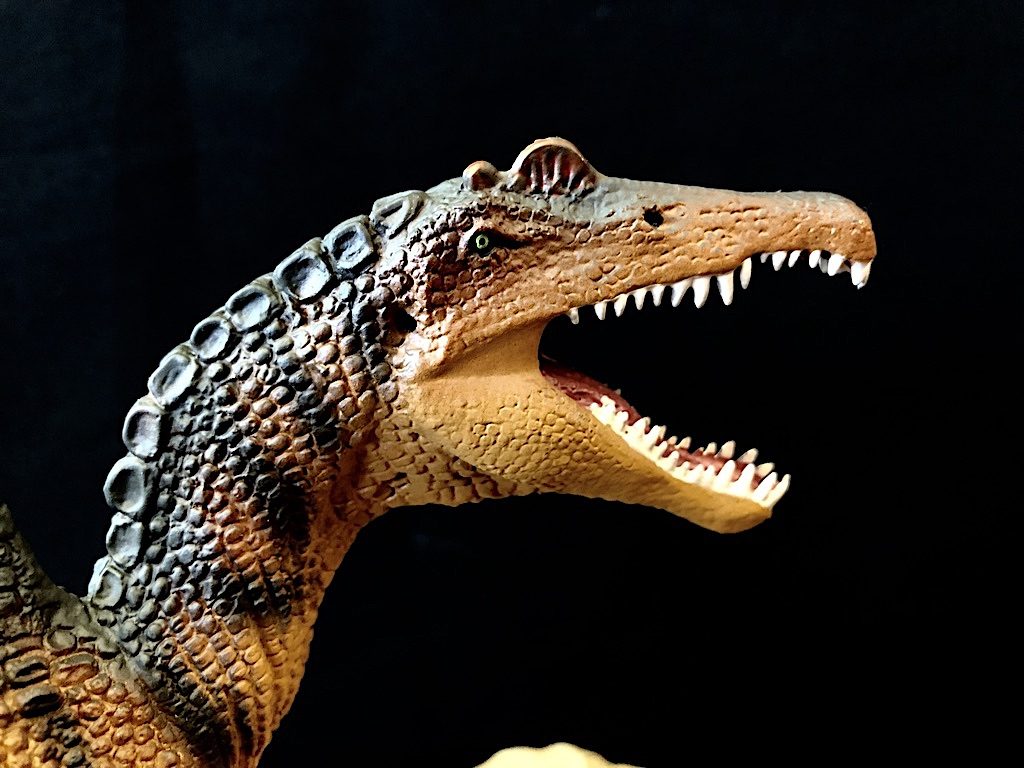
The checks are painted brown, a nice departure from the bubble gum red that always looks unnatural to me. The distinctive notch on the upper snout tip is, surprisingly, not very pronounced on this figure. It’s there, but very subtle, just a slight dent.
On top of the narrow skull we see the crest just above the eyes. The eyes are very small and painted yellow, and just below the eyes we see the hole for the ears.
The first large dermal osteoderms starts at the back of the skull and runs down the entire length of the neck. There are two rows of these on the neck. As it reaches the base, it then spilts into three rows of varying sizes. These row flank the base of the sail, with the top row closest to the base of the sail being the smallest in size that almost disappear midway down the back. The other two rows are the same size and they continue all the way down to the base of the tail where they again meet, then merge to produce a single row of larger scutes and becomes more elevated as it reaches the halfway point in the tail.

There is no mistaking that the design was inspired heavily by crocodiles, especially how the tail looks. This crocodilian tail seems to be the new go-to looks for most of the major brands these days. I guess we can blame CollectA for starting the trend.

The overall body colors also inspired by crocodiles with brown, black, ochre, yellow being the most dominant colors. A black band starts from the back of the skull and runs along the back and edge of the sail. These turns into stripes as it runs down the neck, sail, and body, turning into bands as it reaches the tail.
A combination of orange, brown, rust color of varying hues fill up the spaces between the black stripes all over the body. The overall effect is wonderfully crocodilian, and thats a good thing and works really well for a semi-aquatic animal. The tail is muscular as it should be since this would have been the one area of the body that propel the entire bulk of the animal as it swims around strong currents and tidal flows. The tail has a nice S curve to it.
The distinctive sail was once commonly depicted as being half-circle in shape, very much like that of Dimetrodon, an animal that also have a back sail. Now, we known that the shape is not a perfect half-circle, instead, we see a dip somewhere around the middle of the sail. This dip creates two raised tips.
There are many versions of how the sail is depicted. Some show some sort of prominent keratin sheet tips at the ends, this can be seen in the Favorite version, while others show just a small knob, also covered in keratin, as seen in the CollectA version. On this figure, Safari opted for the completely covered look. Where we would expect to see some sort of tips showing, we instead see a smooth edges. It is also worth noting that while it’s CollectA and Favorite predecessors shows outlines of the tall neural spines under the skin, this Safari version does not. The tall neural spines are completely obscured by skin and flesh giving it a smooth surface.
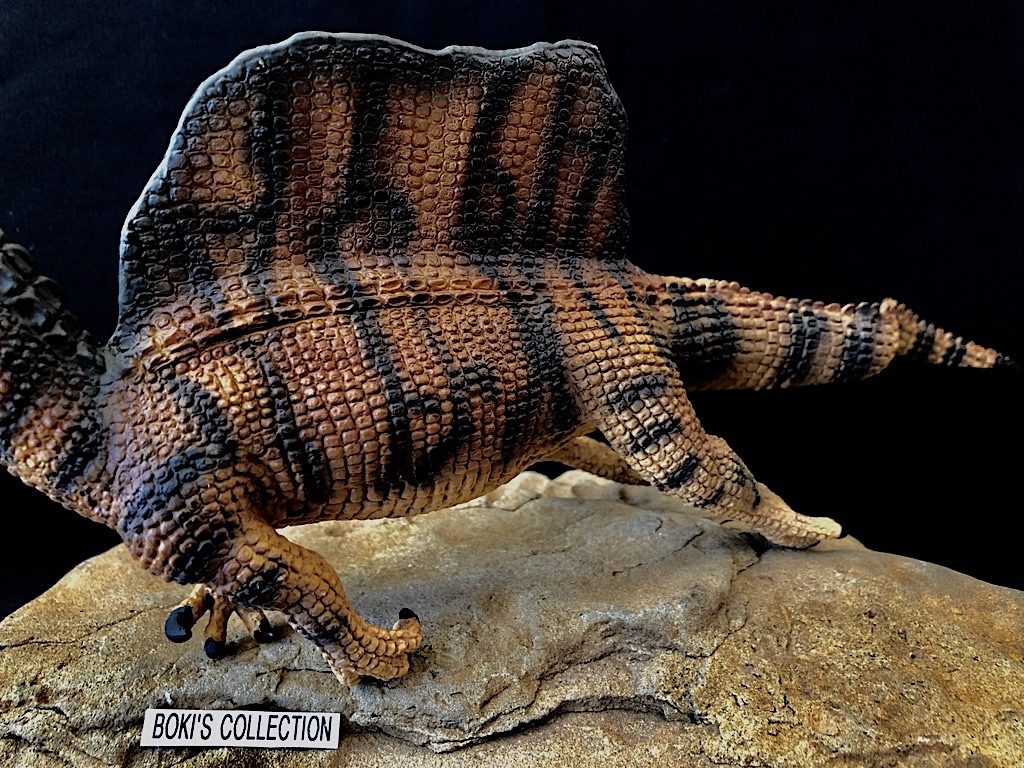
One detail that really stands out for me is the size and shapes of the scales/osteoderms. The details is wonderful, but unfortunately, they are so uniform in size and shape. One would expect variations in at least the sizes of the osteoderms/scales depending on location in the body. We don’t see enough of that in this figure.
It would have been less obvious if this was true only in the body, but alas, the same size and osteoderm shapes can also be seen all the way up the sail.
This is unfortunate since it really looks very distracting and unnatural looking. It would have been better if the sail was made smoother and given much smaller scales.
As a result, there is no clear scales/osteoderms transition between the body and the sail. This gave the impression of one continuous skin from the torso all the way up to the top of the sail.
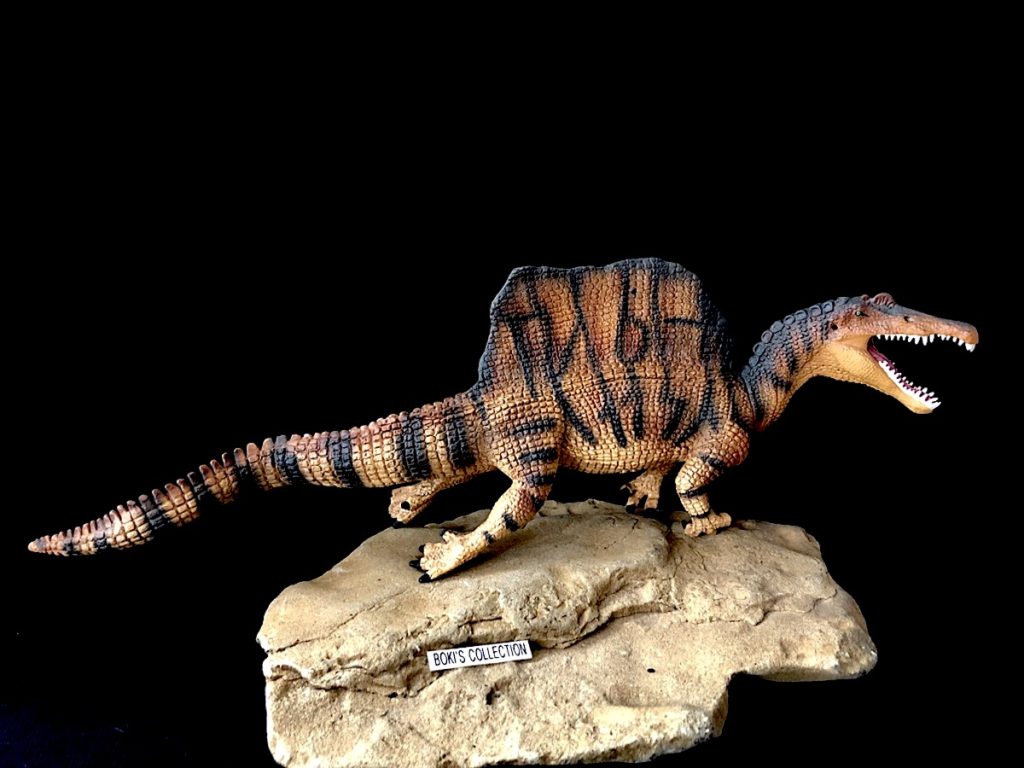
As they say, first impressions are very important. This is especially true if you don’t know much about the subject. Our first impression often dictates how we interpret something we see before we even find out any information. This brings us to the swimming pose of this figure. Although I am aware of the new Spinosaurus reconstruction and this figures swimming pose, still, when I first saw this figure, my very first impression was that it looks like an animal with a broken legs.
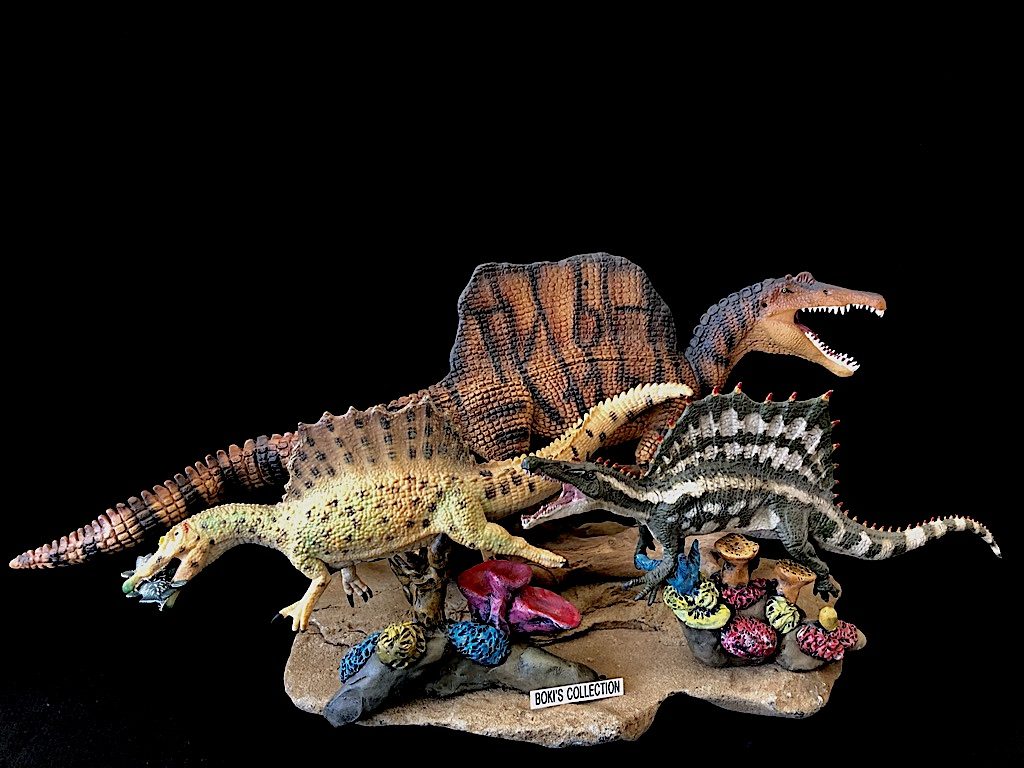
Putting the figure in a swimming pose was a very safe option given that there is still no consensus as to how Spinosaurus in this new reconstruction may have held, oriented, and used its hands while out of the water. So I understand why this pose was chosen. That being said, I feel that here again we see some missed opportunity to be creative. The entire pose looks so contrived and not very flexible for imaginative displaying.
This is one figure that I believed would have really benefited from having a base to help translate its swimming pose better, heck, even putting a fish on its mouth would have help. As I look at it more side-by-side with its CollectA and Favorite swimming posed predecessors, the more I came to the conclusion that it is the orientation of the neck and head that gave this figure such static look. In both of its predecessors, the necks are in a more dynamic pose that helped give the figure more flexible, allowing for better presentation.
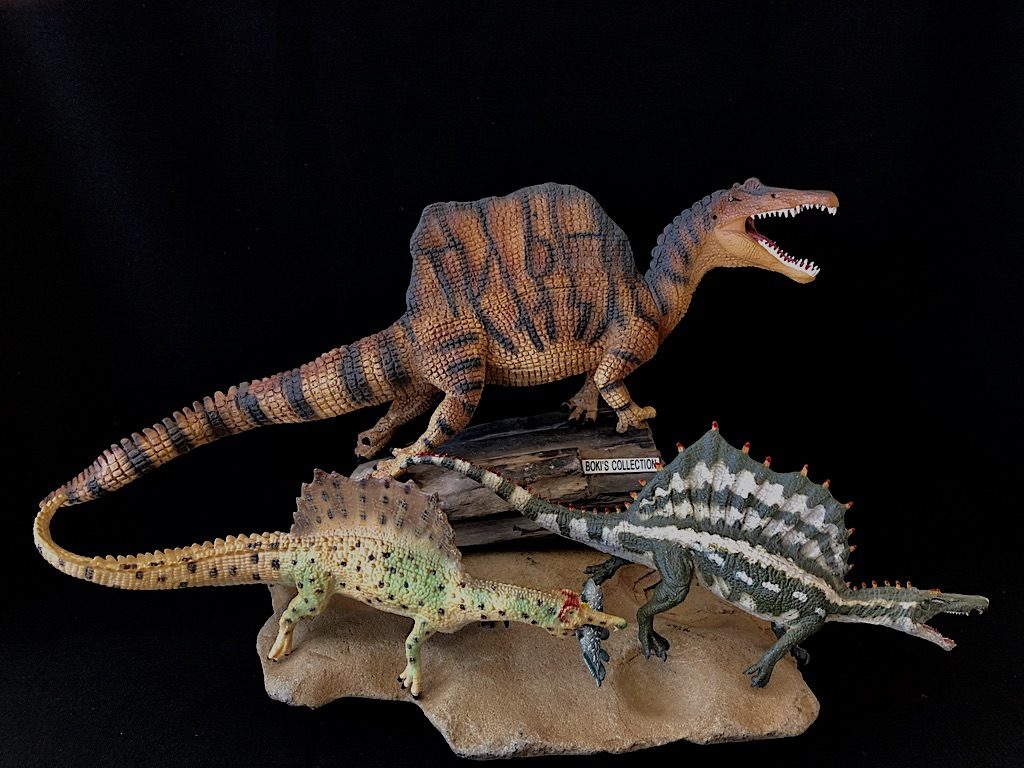
In the CollectA version, the head is held down, with the neck oriented downwards as if the animal is searching or trying to catch some tasty prey below.
The Favorite version had its neck held straight forward in a horizontal orientation. This works well for posing it swimming at the surface, moving against the currents as it swims upstream.
Both figures also have their legs posed in different positions, again this allows for more flexibility besides swimming, the former can be posed as if the animal is hauling itself to dry land, the latter posed downwards as it is about to hurriedly enter the water.
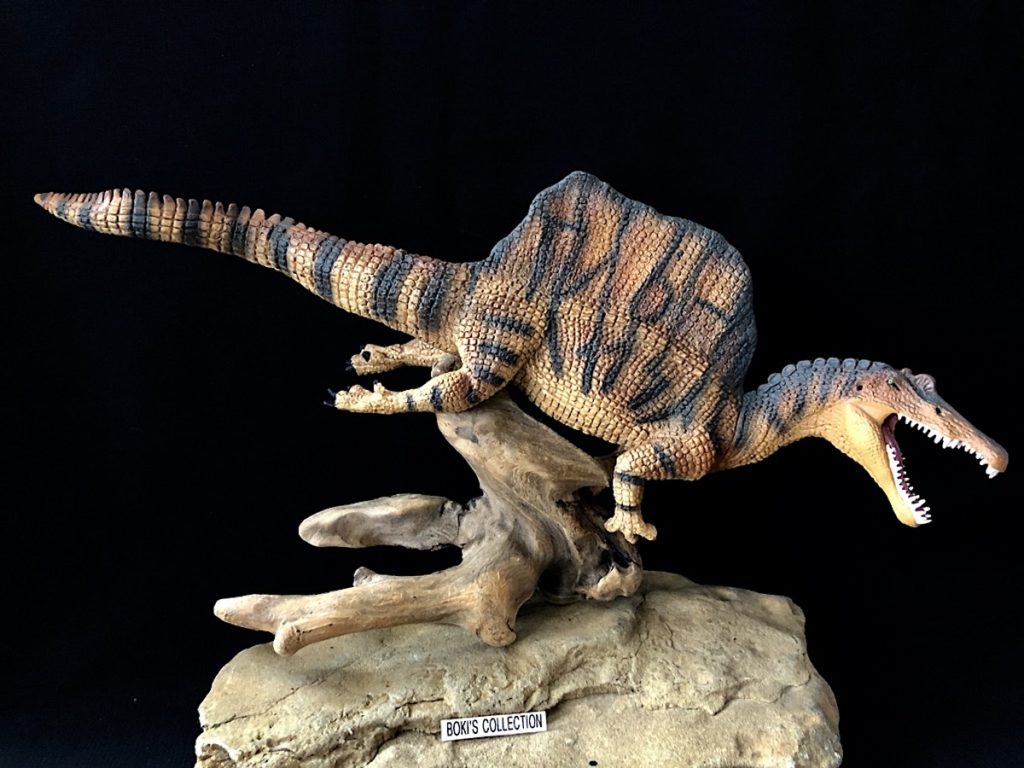
In this new Safari figure, the neck and head are oriented in a more vertical position, with the neck in a S pose. This make positioning the figure a challenge visually. If you orient this figure besides a horizontal surface pose, it will make it looks awkward and unnatural. As a result, the figure is stuck in a pose that clearly meant to be just on the water surface, floating… like a duck.

Was Spinosaurus able to float on the surface like a duck? Probably, but I’m not sure how far out above of the waterline it would have floated given the size and weight of the animal, but who knows.

From left to right: Mawsonia,Onchopristis,Bawitius,Neoceratodus, and small short-neck plesiosaur
Both back legs are thrust far back in the act of propelling itself in the water or maybe just hanging on the side relaxed like a crocodile basking on the waters surface. Visually, it would have been better if both back legs are slightly positioned differently. This would have given the figure a little more movement. These back feet are webbed as well, and you can see some nice details even on the pads.
The problematic arms and hands are held close to the body in a relaxed pose. They help the figure “stand”, the nails touching the ground.
Although the arms are solid and strong plastic, I have a feeling that it will slowly start to curl inwards in time due to the weight. Displaying it on a base or a riser will help prevent this from happening.
In closing, for me, this figure fell short in many ways. It had great potential, but the static pose just prevented it from being a little more creative and less contrived. No doubt that this is one of the most accurate version of this new reconstruction.
The sculpting and detailing are top notch, as expected, but theses qualities are not enough for me to be excited about it, after all, with so many new Spinosaurus version, I’m starting to feel the fatigue.
This figure also had the misfortune of being released this year, where it would go head-to-head with not just two, but even potentially four new versions from other brands. Thats a lot of competition, and from what I have seen from the promo pictures so far, each of these new version have something a little different to offer, be it in pose or speculative details.
So yeah, difficult year for this Safari Spinosaurus to stand out from the pack, if it was released in 2018, it would be a different story.
In the end, it is still a nice big figure that captures Safari’s take on this new reconstruction, well worth adding to a collection, especially for those who are a big fan of the species.
Spinosaurus will continue to keep us guessing to what it’s true nature is. It has kept its secrets very well for over a hundred years. For now, this new reconstructions seems to be gaining wider acceptance.
Until a fully articulated and complete fossil turns up, I guess we can just enjoy the ride.
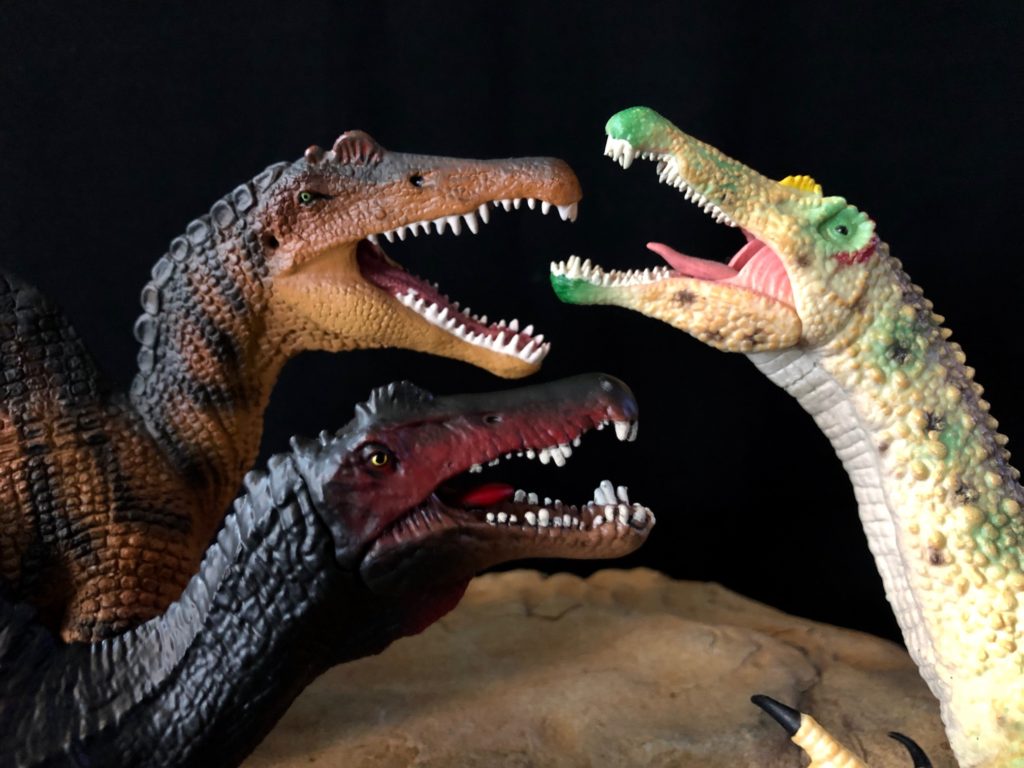
I hope that you all enjoyed the review despite it length, and thanks for reading. Until the next one, take care.
Cheers!
Support the Dinosaur Toy Blog by making dino-purchases through these links to Ebay and Amazon. Disclaimer: links to Ebay.com and Amazon.com on the The Dinosaur Toy Blog are often affiliate links, when you make purchases through these links we may make a commission

Thanks for doing such a thorough review! As familiar as most of us regulars probably are with the animal’s history, I think the coverage was warranted here, due to the number of new figures out as mentioned.
Your photos definitely do the figure justice; while I’m starting to get tired of the crocodile appearances in replicas, and the back legs still look odd to me, it’s clear a lot of effort went into this figure, and it should look great on any shelf alongside its giant theropod kin.
I tried to post comment couple days ago but something went wrong, so let me just link to my twitter thread:
https://twitter.com/MattZetaBaen/status/1106213672009891840
Hot dang this thing has grown on me. I never realized just how much my life necessitated a giant Cretaceous Croco-duck until now.
Excellent review, Bokisaurus! It was a pleasure to read it.
I almost completely agree with you. This model for me, apart to be a missed opportunity, it’s also awful and mediocre. Plus, the paragraph about the aging of the legs confirmed my determination to not buy this figure.
“… still, when I first saw this figure, my very first impression was that it looks like an animal with a broken legs…”
This paragraph really made me laugh. I didn’t noted that! You’re completely right, tough.
Killekor
This is an excellent review, and I appreciated the overview of Spinosaurus reconstructions, its relatives, and its habitat.
However I differ in that this Spinosaurus is my favorite so far, although the upcoming Papo, PNSO, and Rebor (if the latter two are ever released) may change my mind. There is no right nor wrong in personal preferences, and even some of the science concerning particular features can be uncertain and in flux. So we’re left with whether features are scientifically allowable or precluded.
The back legs do not seem out of the range of motion seen in some paleoart, including these by Davide Bonadonna, official illustrator of the Ibrahim-Sereno reconstruction:
https://www.sciencemag.org/news/2014/09/only-known-swimming-dinosaur
(second image in gallery of article below)
https://www.timeout.com/tokyo/kids/the-dinosaur-expo-2016
As for the large and mostly uniform scales, reptiles differ in uniformity of scales, and something similar is seen in this depiction of Spinosaurus (not that I’m suggesting that it influenced Safari ’19):
https://en.wikipedia.org/wiki/Spinosaurus#/media/File:Spinosaurus_durbed.jpg
I interpret the position of the animal as wholly underwater, with three of the legs passive and the right limb perhaps moving forward in tandem with the head turning right and raised as it spots something of interest.
A very comprehensive and well-illustrated review of this new figure; I particularly liked the images of the multiple versions of this animal, be they historic releases or the current wave of Spinosaurus’s taking over the retail listings.
Fantastic photos, as always!
Great species, amazing figure. Dave Martill, my former lecturer and one of the people who worked on the new material of spino, would not stop talking about this. As odd as the stance is, he made a very convincing argument for it
Nice and complete review of this iconic toy dinosaur. Still in Europe we are expecting to receive it but that this spinosaurus on a 1:35 scale makes the spinosaurus of Safari 2019 a miniature dinosaur of considerable size as can be seen with the numerous comparative photographs of this figure with those of the same brand or similar (Carnegie) and that of other companies. I congratulate you for your realistic and meticulous review.